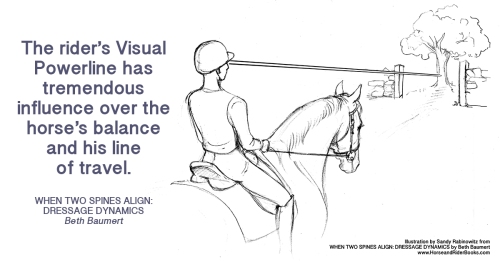In WHEN TWO SPINES ALIGN: DRESSAGE DYNAMICS author Beth Baumert explains the four physical “Powerlines”—Vertical, Connecting, Spiraling, and Visual—that she says enable us to become balanced and effective in the saddle. The Visual Powerline influences the horse’s balance, as well as his line of travel.
The trajectory of the rider’s eyes is a Visual Powerline that goes out from your body—that is, outside the physical system. It connects you and your horse to the outside world. Your body spirals onto your line of travel, and your eyes focus on a point—a dressage letter, tree, fencepost, or a jump—and use it as a frame of reference so the horse can be directed on a planned course.

The rider who is constantly looking at her horse’s neck has a problem similar to the one who clutches the saddle with her legs. She will always be in her horse’s balance; she uses her horse’s balance as a frame of reference because she never looks outside it. The rider who stares at her horse’s neck is committed to being “on the forehand” and can’t influence her horse otherwise. Some riders have nervous eyes; they furtively glance here and there. The horse might experience this behavior in the same way a rider experiences a horse that is always looking this way and that. Maybe it’s distracting; it surely can’t help.
The trajectory of the rider’s eyes has amazing influence over the horse’s balance. It can help put horse and rider in a downhill, horizontal, or uphill balance. The angle of the floor of your seat in relation to the ground and your torso’s position is determined by the horse’s balance, but it is influenced by the trajectory of your eyes. When the trajectory is in a downhill balance, your seat is not only inclined to be downhill, but it actually can’t follow the horse’s back.
When the trajectory of the eyes is horizontal, the floor of your seat offers the possibility of a horizontal frame for the “downhill” horse. It influences the horse’s spine to travel in a horizontal path, thus improving his natural balance. The horse’s horizontal frame puts the floor of the rider’s seat in a horizontal position. When the rider is in self-carriage with the trajectory of her eyes on a horizontal line, she can influence the horse to come into an uphill posture.
If you have problems with the trajectory of your eyes, imagine “half-halting” with your head. This encourages you to inhale and shift your head up, which improves your horse’s balance both longitudinally and laterally. It puts the trajectory of your eyes on the line that encourages your horse to become better balanced. Your seat can’t work when your head isn’t balanced over the place where the two spines meet.
Try this exercise:
Step 1 Hold on to just the buckle of your reins with one or both hands, and keep your hands over the pommel of your saddle.
Step 2 Use your eyes to chart your course. Be aware of how your eyes relate to the rest of your body. Your head will want to lead and misalign your body, but don’t let it. Be sure your hands, shoulders, knees, and toes also point the way.
Step 3 Track left and spiral onto a diagonal line of travel. Weight your left seat bone slightly and turn with your outside (right) aids. Be aware of how your weight works. You might need to use more outside leg than you expected.
Step 4 As you finish your diagonal line, spiral right to turn right. Weight your right seat bone slightly and turn with your outside (left) aids. Be persistent about your horse following your body.
Step 5 When your horse is able to understand your body language, pick up the reins and begin your warm-up. You’ll find that your horse is more in tune with your body language, and you only need very subtle rein aids.
Learn about the other three Powerlines in Baumert’s bestselling book WHEN TWO SPINES ALIGN: DRESSAGE DYNAMICS, available now from the TSB online bookstore, where shipping in the US is FREE.
CLICK HERE for more information.
Trafalgar Square Books, the leading publisher of equestrian books and DVDs, is a small business located on a farm in rural Vermont.


